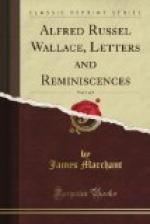My dear Thomas,—I will now try and write you a few lines in reply to your last three letters, which I have not before had time and inclination to do. First, about your one-eyed and two-eyed theory of art, etc. etc. I do not altogether agree with you. We do not see all objects wider with two eyes than with one. A spherical or curved object we do see so, because our right and left eye each see a portion of the surface not seen by the other, but for that very reason the portion seen perfectly with both eyes is less than with one. Thus [see diagram on next page] we only see from A to A with both our eyes, the two side portions Ab Ab being seen with but one eye, and therefore (when we are using both eyes) being seen obscurely. But if we look at a flat object, whether square or oblique to the line of vision, we see it of exactly the same size with two eyes as with one because the one eye can see no part of it that the other does not see also. But in painting I believe that this difference of proportion, where it does exist, is far too small to be given by any artist and also too small to affect the picture if given.
[Illustration]
Again, I entirely deny that by any means the exact effect of a landscape with objects at various distances from the eye can be given on a fiat surface; and moreover that the monocular clear outlined view is quite as true and good on the whole as the binocular hazy outlined view, and for this reason: we cannot and do not see clearly or look at two objects at once, if at different distances from us. In a real view our eyes are directed successively at every object, which we then see clearly and with distinct outlines, everything else—nearer and farther—being indistinct; but being able to change the focal angle of our two eyes and their angle of direction with great rapidity, we are enabled to glance rapidly at each object in succession and thus obtain a general and detailed view of the whole. A house, a tree, a spire, the leaves of a shrub in the foreground, are each seen (while we direct our eyes to them) with perfect definition and sharpness of outline. Now a monocular photo gives the clearness of outline and accuracy of definition, and thus represents every individual part of a landscape just as we see it when looking at that part. Now I maintain that this is right, because no painting can represent an object both distinct and indistinct. The only question is, Shall a painting show us objects as we see them when looking at them, or as we see them when looking at something else near them? The only approach painters can make to this varying effect of binocular vision, and what they often do, is to give the most important and main feature of their painting distinct as we should see it when looking at it in nature, while all around has a subdued tone and haziness of outline like that produced by seeing the real objects when our vision is not absolutely




